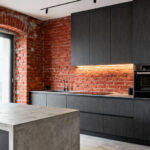As I run my fingers along the smooth grain of a beautifully crafted kitchen cabinet, I can’t help but marvel at how something so simple can transform an entire space. There’s a certain magic in the way classic design styles have stood the test of time, evolving yet retaining their essence. It’s this timeless elegance that we’ll explore today, diving into five kitchen cabinet makeover ideas that draw inspiration from beloved design traditions.
From the clean lines of Shaker simplicity to the raw appeal of industrial chic, we’ll journey through a world of possibilities for breathing new life into your kitchen. Whether you’re a DIY enthusiast ready to roll up your sleeves or simply dreaming of a kitchen refresh, these ideas will spark your imagination and guide you toward creating a space that’s both functional and filled with character. So grab a cup of coffee, and let’s embark on this adventure of timeless design together.
The Enduring Charm of Shaker Cabinets
There’s something about Shaker cabinets that just feels like home. Let’s dive into the world of Shaker cabinets and discover why they continue to be a favorite in kitchens across the country.

Historical Context and Design Principles
The Shakers, a religious group known for their commitment to simplicity and functionality, developed a distinct style of furniture-making that has stood the test of time. Their belief in honest craftsmanship and the avoidance of unnecessary ornamentation led to the creation of pieces that are as beautiful as they are practical.
Key characteristics of Shaker cabinet doors include:
- A five-piece door with a recessed center panel
- Minimal ornamentation
- Clean, straight lines
- High-quality wood construction
The Shakers’ dedication to quality is evident in their use of durable woods and techniques like dovetail joinery, which contribute to the longevity of their pieces. It’s this commitment to craftsmanship that allows Shaker-style cabinets to remain a beloved choice in modern kitchens.
Modern Interpretations and Variations
While traditional Shaker cabinets often feature natural wood finishes like maple, cherry, or walnut, today’s interpretations offer a wider range of options. For those looking to add a contemporary twist, painted finishes in muted tones can breathe new life into the classic design.

Here are some ways to incorporate Shaker cabinets into different kitchen layouts:
- Open-concept kitchens: Use Shaker cabinets as a unifying element to tie together different areas of the space.
- Galley kitchens: Opt for light-colored Shaker cabinets to create an illusion of more space.
- L-shaped kitchens: Mix and match upper and lower Shaker cabinets for visual interest.
- Island-centric kitchens: Feature a contrasting color or finish on the island’s Shaker cabinets for a focal point.
When it comes to hardware, simplicity is key. Cup pulls or knobs in brushed nickel or oil-rubbed bronze complement the clean lines of Shaker cabinets beautifully. Remember, less is more when it comes to this timeless style.
Bringing Shaker Style Home
If you’re considering a Shaker-inspired kitchen makeover, here are a few tips to keep in mind:
- Focus on quality materials – invest in solid wood cabinets for authenticity and durability.
- Keep the color palette simple – whites, creams, and earth tones work well with Shaker style.
- Let the craftsmanship shine – avoid cluttering the space with too many decorative elements.
- Consider adding glass panels to some upper cabinets for a light, airy feel.
- Incorporate natural elements like wooden countertops or stone flooring to complement the Shaker aesthetic.
By embracing the principles of simplicity and functionality that inspired the original Shaker furniture makers, you can create a kitchen that’s both timeless and uniquely yours. It’s a style that adapts beautifully to modern life while maintaining a connection to its rich history.

As we move from the clean lines of Shaker style to our next design inspiration, get ready to embrace the cozy charm of farmhouse kitchens. In the next section, “Rustic Warmth: Embracing Farmhouse Style,” we’ll explore how to infuse your kitchen with that inviting, down-home feel that makes farmhouse design so irresistible.
Rustic Warmth: Embracing Farmhouse Style
There’s something magical about transforming a kitchen with the timeless charm of rustic simplicity. Let’s roll up our sleeves and dive into the world of farmhouse-inspired cabinet makeovers.
Essential Elements of Farmhouse Cabinetry
Farmhouse style is all about creating a space that feels lived-in, comfortable, and inviting. When it comes to cabinets, think of natural materials and time-worn finishes. Here are some key elements to consider:
- Reclaimed wood: Nothing says farmhouse quite like cabinets crafted from reclaimed barn wood or distressed pine. The knots, scratches, and imperfections tell a story and add character to your kitchen.
- Soft, muted colors: While classic white is always a winner, don’t be afraid to explore other hues. Soft grays, warm creams, and even muted blues can create a cozy farmhouse vibe.
- Open shelving: Replace some upper cabinets with open shelves to display your favorite dishes or vintage finds. It’s a practical solution that adds visual interest and a touch of nostalgia.
- Vintage-inspired hardware: Swap out modern pulls for antique bin pulls or porcelain knobs. These small details can make a big impact on the overall look.

Pro tip: If you’re working with a small kitchen, consider using a mix of closed cabinets and open shelving. This balance will give you the farmhouse feel without overwhelming the space.
Creating a Welcoming and Lived-In Aesthetic
The beauty of the farmhouse style lies in its ability to make everyone feel at home. Here’s how to infuse that welcoming spirit into your cabinet makeover:
- Embrace imperfections: Don’t stress about achieving a perfect finish. A few dings or scratches add to the charm and authenticity of the farmhouse style.
- Mix and match: Combine different wood tones or paint colors for a collected-over-time look. For example, paint your upper cabinets white and leave the lower in natural wood.
- Incorporate glass fronts: Add glass panels to a few cabinet doors to showcase your favorite dishes or collectibles. It’s a great way to add visual interest without fully committing to open shelving.
- Don’t forget the sink: While not technically part of the cabinetry, a farmhouse sink (also known as an apron-front sink) is a quintessential element that complements rustic cabinets beautifully.
When I renovated my kitchen, I stumbled upon an old farmhouse table at a local flea market. I repurposed its weathered top as a countertop for my island, pairing it with simple shaker-style cabinets painted in a warm, creamy white. The result? A perfect blend of old and new that never fails to make me smile.

Remember, the key to a successful farmhouse kitchen is balancing rustic elements with modern conveniences. Don’t be afraid to mix in stainless steel appliances or sleek lighting fixtures. This juxtaposition creates a space that’s both functional and full of character.
As we wrap up our journey into farmhouse-inspired cabinet makeovers, I can’t help but feel excited about the possibilities. Whether you’re working with a sprawling country kitchen or a cozy city apartment, there’s always room for a touch of rustic charm. So grab your paintbrush, hunt for some vintage hardware, and get ready to transform your kitchen into a warm, welcoming haven.
Now, let’s shift gears and explore a style that’s at the opposite end of the spectrum, yet equally captivating. Get ready to roll up your sleeves as we dive into the world of Industrial Chic: A Blend of Raw and Refined. Trust me, you won’t want to miss this exciting fusion of urban edge and polished sophistication.
Industrial Chic: A Blend of Raw and Refined
As I stepped into my friend’s newly renovated kitchen, I couldn’t help but feel transported to a bustling New York loft. The space exuded a rugged charm that perfectly balanced utility and style. This, my friends, is the essence of industrial chic – a design approach that celebrates the raw beauty of factories and warehouses while infusing it with modern sophistication.

Key Materials and Finishes for Industrial Cabinets
When it comes to industrial-inspired kitchen cabinets, it’s all about embracing the beauty of bare materials. Here’s how you can achieve this look:
- Metal accents: Opt for cabinet hardware in dark metal finishes like oil-rubbed bronze or gunmetal. These add an authentic industrial touch without breaking the bank.
- Open shelving: Replace some upper cabinets with open shelves supported by metal brackets. This not only adds visual interest but also provides a perfect spot to display your favorite dishes or vintage finds.
- Reclaimed wood: Consider using reclaimed wood for cabinet doors or as a countertop material. The weathered patina adds character and warmth to the space.
- Concrete elements: While not for everyone, concrete countertops or even cabinet fronts can make a bold industrial statement.
Balancing Functionality and Style
The beauty of industrial chic lies in its ability to marry form and function. Here are some tips to strike the right balance:
- Embrace a neutral color palette: Stick to shades of gray, black, and white for your cabinets, then add pops of bold color through accessories or small appliances.
- Mix textures: Combine smooth metal surfaces with rough wood grains or sleek concrete with textured brick for visual interest.
- Incorporate industrial-inspired lighting: Pendant lights with Edison bulbs or metal cage fixtures can enhance the overall aesthetic.
- Soften the look: Balance the hard edges with soft textiles like a plush rug or woven bar stools to create a more inviting atmosphere.

One of my favorite budget-friendly tricks is to use metal mesh inserts in cabinet doors. It’s a simple DIY project that instantly adds industrial flair without the need for a complete overhaul.
Remember, the key to a successful industrial chic kitchen is to let the materials speak for themselves. Don’t be afraid to leave some imperfections visible – they add to the charm and authenticity of the space.
As we transition from the raw appeal of industrial chic, let’s shift gears and explore another timeless design style. Get ready to take a trip back in time as we dive into the world of Mid-Century Modern: Retro Vibes and Sleek Design. This iconic style offers a completely different take on kitchen aesthetics, proving that sometimes, looking to the past can create a thoroughly modern and stylish space.
Mid-Century Modern: Retro Vibes and Sleek Design
There’s something magical about the clean lines and functional beauty that define this iconic style. Let’s dive into how we can bring that timeless elegance into our kitchens today.

Signature Elements of Mid-Century Modern Cabinets
Mid-century modern design is all about simplicity and function, with a dash of retro cool. To capture this look in your kitchen cabinets, focus on:
- Clean, horizontal lines
- Minimalist hardware (think slim bar pulls or subtle finger pulls)
- Natural wood finishes, especially walnut and teak
- Geometric shapes and patterns
- A mix of materials, like wood and laminate
Pro tip: For an authentic touch, consider using wood veneer on your cabinet fronts. It’s a sustainable option that gives you that genuine mid-century look without breaking the bank.
Incorporating Retro Colors and Patterns
One of my favorite aspects of mid-century design is its playful use of color. Don’t be afraid to inject some personality into your kitchen with:
- Bold, saturated hues like mustard yellow, avocado green, or burnt orange
- Geometric patterns on backsplashes or cabinet inserts
- Two-tone cabinet designs, mixing wood tones with pops of color
Remember, less is more. Choose one or two statement colors and balance them with neutral tones to avoid overwhelming the space.

Mid-Century Meets Modern: Blending Old and New
You might be wondering, “Caleb, how can I make this retro style work in my contemporary kitchen?” It’s all about finding that sweet spot between vintage charm and modern functionality. Here are some ideas:
- Pair mid-century cabinet styles with sleek, modern appliances
- Use quartz countertops for a durable, low-maintenance surface that complements the clean lines of mid-century design
- Incorporate smart storage solutions behind those beautiful cabinet fronts
- Add vintage-inspired lighting fixtures to tie the look together
Iconic Designers and Their Influence
No discussion of mid-century modern design would be complete without mentioning some of the visionaries who shaped this style. Designers like Charles and Ray Eames, Eero Saarinen, and George Nelson created furniture pieces that are still coveted today. While you might not be able to fill your kitchen with original Eames chairs, you can certainly draw inspiration from their innovative use of materials and emphasis on functionality.
DIY Mid-Century Cabinet Makeover
For those of you who love to roll up your sleeves and get hands-on (like me!), here’s a quick guide to giving your existing cabinets a mid-century facelift:
- Sand and prep your cabinet fronts
- Apply a wood veneer or high-gloss laminate finish
- Replace old hardware with sleek, minimalist pulls
- Consider adding tapered legs to base cabinets for that quintessential mid-century look

Remember, the beauty of mid-century design lies in its simplicity. Don’t overdo it – let the clean lines and quality materials speak for themselves.
As we wrap up our journey through the world of mid-century modern kitchens, I hope you’re feeling inspired to bring a touch of retro cool to your own space. Whether you go all-out with a complete cabinet overhaul or simply add a few mid-century-inspired elements, remember that the key is to create a kitchen that’s both functional and beautiful.
Now, let’s take things up a notch and explore how we can blend different classic styles to create a truly unique kitchen. In our next section, “Creating a Fusion: Blending Classic Styles,” we’ll discover how to mix and match elements from various design eras for a look that’s all your own.
Creating a Fusion: Blending Classic Styles
When I visited my friend’s newly renovated kitchen, I couldn’t help but marvel at the seamless blend of classic design elements. The Shaker-style cabinets paired with industrial pendant lights created a harmonious contrast that felt both timeless and fresh. It was a perfect example of how mixing and matching different styles can result in a truly unique and personal space.
Tips for Mixing and Matching Design Elements
When it comes to blending classic styles in your kitchen, the key is to find a balance between cohesion and contrast. Here are some ideas to get you started:
- Start with a neutral base: Use a neutral color palette for your cabinets and walls to create a versatile backdrop for bolder design elements.
- Choose a dominant style: Select one classic style as your primary influence, then incorporate elements from other styles as accents.
- Look for common threads: Identify similar features or materials across different styles to create a sense of unity.
- Play with textures: Mix smooth and rough textures to add depth and interest to your kitchen design.
- Experiment with hardware: Use cabinet hardware as an opportunity to introduce elements from different styles.

Creating a Cohesive and Stylish Look
The beauty of blending classic styles lies in the ability to create a kitchen that’s uniquely yours. However, it’s important to ensure that your design feels intentional and cohesive. Here are some tips to help you achieve a polished look:
- Maintain consistent proportions: Keep the scale of your design elements in harmony to avoid a cluttered or disjointed appearance.
- Use color to unify: Choose a color scheme that ties different elements together, creating a sense of continuity throughout the space.
- Repeat design elements: Incorporate recurring shapes, patterns, or materials to create a sense of rhythm in your kitchen.
- Balance old and new: Mix vintage or antique pieces with modern elements to create an eclectic yet timeless feel.
- Consider the overall flow: Ensure that your blended design complements the rest of your home’s aesthetic.
One of my favorite combinations is pairing farmhouse-style open shelving with sleek, mid-century modern furniture. The warmth of the wood shelves contrasts beautifully with the clean lines of the furniture, creating a space that feels both inviting and sophisticated.
Avoiding Common Design Mistakes
While blending styles can lead to stunning results, there are a few pitfalls to watch out for:
- Overcrowding: Resist the urge to incorporate too many different elements. Remember, less is often more.
- Ignoring function: Don’t sacrifice practicality for style. Ensure your kitchen remains functional and efficient.
- Neglecting lighting: Proper lighting is crucial in tying different design elements together and creating the right ambiance.
- Forgetting about transitions: Pay attention to how different styles flow into one another to avoid abrupt changes.

By keeping these potential issues in mind, you’ll be better equipped to create a harmonious blend of classic styles that feels both intentional and effortless.
As we wrap up our exploration of timeless kitchen cabinet makeovers, it’s clear that the possibilities are endless when it comes to creating a space that reflects your style. Whether you choose to embrace a single classic design or blend elements from various styles, the key is to approach the process with creativity and an open mind.
In our final section, we’ll recap the main takeaways from our journey through these classic design styles and offer some parting thoughts on how to bring your dream kitchen to life. So, let’s take a moment to reflect on what we’ve learned and prepare to put these ideas into action.
Final Thoughts
As we wrap up our journey through these timeless kitchen cabinet makeover ideas, I hope you’re feeling inspired to bring a touch of classic elegance into your own home. Remember, the beauty of these design styles lies not just in their aesthetic appeal, but in their ability to adapt and evolve with our changing needs and tastes. Whether you’re drawn to the simplicity of Shaker cabinets, the warmth of farmhouse charm, or the sleek lines of mid-century modern, there’s a world of possibility waiting to be explored.

Don’t be afraid to mix and match elements from different styles to create a space that’s uniquely yours. After all, the best kitchens are those that reflect the personalities and stories of the people who inhabit them. As you embark on your cabinet makeover adventure, keep in mind that the process is just as important as the result. Embrace the journey, learn from the challenges, and most importantly, have fun bringing your vision to life. Here’s to creating kitchens that are not just beautiful, but filled with warmth, character, and timeless elegance for years to come.






